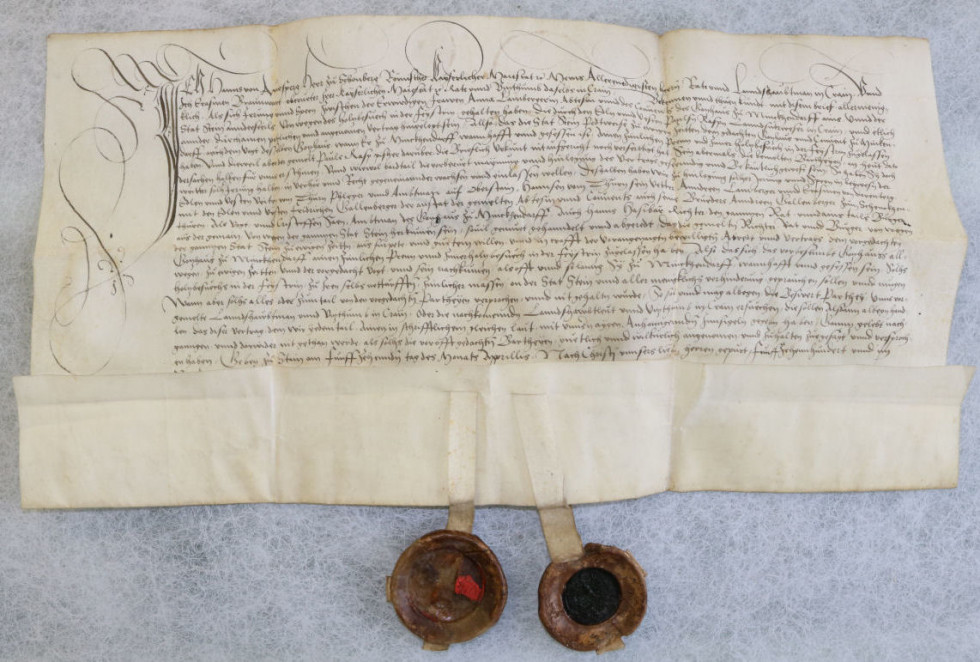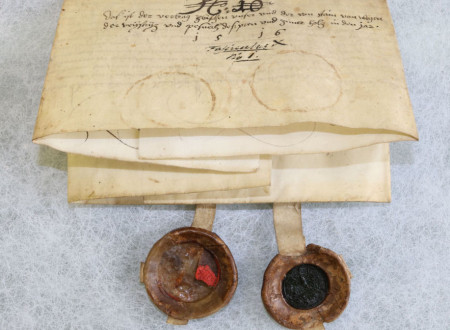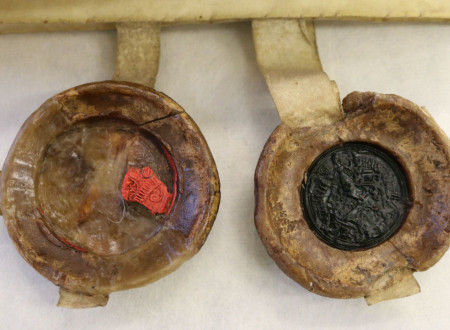Half a Millenium Since the Settling of the Dispute Between the Convent in Mekinje and the Town of Kamnik
In the past, wood was an important element used in construction and for a number of other purposes as well, such as for heating, charcoal burning etc. The situation in Kamnik and its surrounding areas was no different. Territorial princes very early on granted the town of Kamnik the right to use vast forests in the vicinity of the Kamniška Bistrica valley. It is no wonder then, that the town slowly came to regard these forest as its property, although legally speaking, Kamnik's ownership over them was not established until 1783, when it was entered into the landed property register (Landtafel). The borders were not accurately defined, but according to Valvasor they reached up to the tree line in the Kamnik Alps, which caused a number of disputes with the neighbouring population, with the owners of the neighbouring manors (such as with the Lambergs of Črnelo castle), and later also with the convent of the Poor Clares in Mekinje, who also claimed certain rights over the Kamniška Bistrica forests (the right to collect firewood or wood for building, the rights of pasture, charcoal burning etc.)
One of such disputes was in 1496 settled by the verdict of the Carniolan governor Wilhelm von Auersperg, who by the order of the territorial prince decided that the common land and the forests in Kamniška Bistrica belonged solely to the town of Kamnik. However, if permitted by the town, livestock owned by inhabitants of the surrounding area was allowed to graze there during the day. Ordered by King Maximilian I., the verdict was confirmed by the Carniolan Vicedom Georg von Egkh and by the steward of the Stari grad in Kamnik Veit von Thurn.
The peasants of the surrounding area were not the only ones with whom the townspeople of Kamnik argued when it came to the forests in Kamniška Bistrica. Also strained were their relations with the princely master huntsman. In his over exaggerated concern for the preservation of wild animals, he tried to prevent the townspeople from stocking up with firewood and from pasturing their livestock. He also threatened to kill all the pigs the people put out to graze there on beech mast, and to burn down the property of cottagers. Territorial prince retained the right to hunt in the Kamniška Bistrica forests until 1667, when he granted it to Count Wolfgang Engelbert Auersperg.
Mid-April 2016 marks the 500th anniversary of the settling of the dispute between the Mekinje convent and the town of Kamnik in regard to the cutting down of trees in the territory of the Kamniška Bistica valley. The verdict was issued by the Carniolan governor and the lord of Schonberg Hans Auersperg (Janns von Auersperg), and by the Carniolan Vicedom Erasem Braunbart (Erasmen Braunwart). The arbiters explained in writing that the dispute in question was between the abbess Ann Lamberg (Anna Lambergerin) and the Mekinje covent (Minckhendorff) on the one hand and the town of Kamnik (Stein) on the other. The dispute had been settled before by the Carniolan administrator Paul Rasp (Paulsn Raspn)who managedto reach an acceptable agreement (durch ainen petlichen vnnd angenomen vertrag hingelegt sein). Unfortunately, Rasp at the time had not issued any written confirmation about the matter, and the dispute dragged on and on despite the fact that both parties agreed with his verdict.
To avoid future conflicts and tensions, the Carniolan governor and the Carniolan Vicedom issued a charter. During the signing of the charter a number of witnesses were present: Veit von Thurn (Veiten vom Thurn), a steward and amtman in Upper Kamnik (Oberstain), his relative Hans von Thurn (Hanness vom Thuren), Andree von Lamberg (Anndreen Lamberger), Erasem von Dornberg (Erasmen von Dorenberg), Friedrich Gallenberg (Fridrichen Gallenberger), the attorney of the convent in Mekinje, his brother Andree Gallenberg of Šinkov Turn (Anndreen Gallenberger zum Schenckhenthuren) as the attorney of the convent, Christoph Saan (Cristoffen Saen), amtman (steward) of the Mekinje convent, Hans Hasiber (Hanns Hasibar), the town judge in Kamnik, and the entire town council as well as a number of townspeople (aus der gemain).
The arbiters determined for all eternity (zu ewigen zeittn), in good will, and in the light of the submitted and accepted agreement, that the town of Kamnik had to allow the convent in Mekinje and its attorney - when he resided there – a sufficient cutting down of firewood and building wood for their own needs. The town should not obstruct such actions in any way. Should one of the party violate this agreement, the other party may turn for help directly to the aforementioned governor and Vicedom or to their successors who had to ensure that the provisions of the agreement were respected. Similar right to wood was later granted also to the Franciscan monastery in Kamnik.
The charter is written in two identical copies and authenticated with two pendant seals of the Carniolan governor Hans von Auersperg, lord of Šumberk (Schonberg), and of the Carniolan Vicedom Erasem Braunbart.
The charter we are presenting here is kept in the Collection of charters at the Archives of the Republic of Slovenia (SA AS 1063) and is one of the 220 charters in the series Charters of the Convent of the Order of the Poor Clares in Mekinje. Up until the dissolving of the convent in 1782, the charters were kept in Mekinje. After that they were taken to Vienna to Haus-, Hof-und Staatsarchiv and returned to Slovenia in the second half of the 20th century. Since 2005 the entire collection of charters has been digitized, and individual charters can also be accessed online, among them also the here presented charter.
Jure Volčjak





